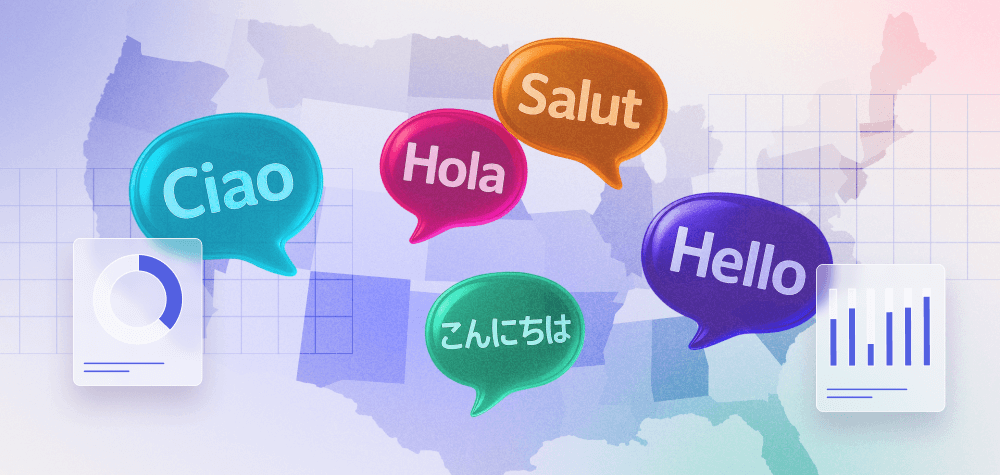When the NFL announced Bad Bunny as the headliner for the 2026 Super Bowl Halftime Show, it was both a pop culture moment and a reflection of how the United States itself is changing. After speaking briefly in Spanish, the Puerto Rican superstar joked during his Saturday Night Live appearance that “if you didn’t understand what I just said, you have four months to learn.”
The line landed because, in many ways, he’s right: The U.S. is becoming more multilingual by the day.
To explore this shift, Start.io recently analyzed anonymized mobile data that reveals how people actually communicate on their phones: the languages they install, switch between, and use to connect with their world. The findings show clear growth in multilingualism, as well as an interesting intersection of the fandoms most likely to be watching this year’s Super Bowl Halftime Show.
Language Use on U.S. Mobile Devices Is Becoming More Diverse
According to Start.io’s latest data, about 11% of Americans now use two or more keyboard languages on their smartphones. That marks an increase of roughly 2 percentage points since the company’s previous analysis in May 2024, when 9% of devices showed multilingual setups.
The change might seem small, but across tens of millions of devices, it reflects millions more people living bilingual or multilingual lives, often toggling between English and another language for everyday communication.
Among multilingual users, Spanish remains by far the most common secondary language, whether used alongside English or with another primary keyboard. The combination of English and Spanish still accounts for the majority of bilingual setups, echoing the cultural reality that Spanish is by far the second most widely spoken language in the U.S.
Dual-Language Users by State
The rise in bilingualism is most visible at the state level, where Spanish overwhelmingly leads as the non-English keyboard of choice. The table below highlights the 10 states where Spanish is most common among dual-language users, offering a snapshot of where multilingual communication is strongest in everyday mobile life.
The 10 states with the highest concentration of dual-language users who speak Spanish:
| Rank | State | Users | % of Dual-Language Users (Spanish) |
|---|---|---|---|
| 1 | Texas | 1,811,890 | 82.4% |
| 2 | Florida | 1,265,803 | 78.8% |
| 3 | New Mexico | 71,540 | 78.5% |
| 4 | Arizona | 311,231 | 74.9% |
| 5 | Colorado | 234,594 | 73.9% |
| 6 | Utah | 116,775 | 73.0% |
| 7 | Maryland | 253,842 | 72.9% |
| 8 | Nevada | 139,000 | 72.8% |
| 9 | Oklahoma | 138,374 | 72.8% |
| 10 | California | 973,392 | 72.7% |
Football, Fandom, and Bad Bunny
Language isn’t the only lens through which Start.io examines cultural trends. Start.io also analyzed mobile signals from millions of U.S. devices, which offers a unique privacy-safe lens into fandoms and how those fandoms intersect.
Based on Start.io’s data:
- There’s an estimated 3.3 million Bad Bunny superfans in the U.S.
- Of those fans, 1.4 million are also American football enthusiasts.
These are the individuals most likely to be cheering on Bad Bunny alongside their favorite players in this year’s Super Bowl.
What It All Means
It’s too early to predict how language diversity and fandom dynamics will influence Super Bowl viewership or engagement, but the data points toward a cultural moment worth watching.
As multilingualism grows and U.S. audiences increasingly reflect global tastes, events like the Super Bowl are becoming opportunities to celebrate shared experiences that cross languages, borders, and genres.
Methodology
Start.io analyzed anonymized data from millions of smartphones and tablets in the United States, identifying which keyboard languages were installed on each device. Start.io analysts studied keyboard installation rates, but not keyboard usage or volume. Additional data was drawn from Start.io’s mobile audience segments, identifying users categorized as American football enthusiasts and Bad Bunny music lovers.
For more information about this dataset, or to learn how Start.io’s insights can help brands better understand cultural and behavioral trends, contact us here.



